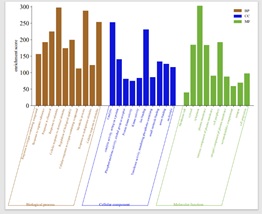In Silico Potential Analysis of Acorus calamus as a Mental Depression Therapy
Abstract
Depression is a common but serious mood disorder. This disease causes severe symptoms that affect one's emotions, thoughts, and daily activities, such as sleep, eating, or working. According to the National Youth Mental Health Survey of Indonesia, in 2022, 15.5 million (34.9%) teenagers suffer from mental disorders and 2.45 million (5.5%) have mental illnesses. Acorus calamus is believed to have antispasmodic, carminative, antihelmintic, aromatic, expectorant, nausea, soothing, sedative, and stimulant properties. It is also used to treat epilepsy and mental illness, chronic diarrhea, dysentery, and stomach pain. This study aims to determine the molecular mechanisms of the bioactive compound antidepressant Acorus calamus using pharmacological tissue analysis. Acorus calamus compound data obtained from Dr. Duke's database, screening of the absorption, distribution, metabolism, and excretion (ADME) of Acorus calamus Compounds with SwissADME, prediction of the Acorus calamus target compounds protein with SwissTargetpPrediction, analysis of the pharmacological network with String-DB and its visualization with Cytoscape version 3.10.1. Searching for the contents of Acorus calamus compounds resulted in 69 components and found 12 compounds that have ADME criteria that match the drug compounds (Drug Likeness/DL). The pathways correlated with therapy are the neurotransmitters of serotonin. The known target proteins are MAOA, ESR1, GRM5, CRHR1, HTR2A, DRD2, SLC6A4 and CHR with compounds that correlate with mental depression therapy, among others Aceteugenol, Acoradin, Acoramone, Alpha-Asarone, Beta-Asarone, Calamenone, Camelone, Elemicin, Isoacorone, Sekishone, trans-Isoelemicine, Epoxyisoacoragermacrone.
References
Balakumbahan, R., Rajamani, K., & Kumanan, K. (2010) ‘Acorus calamus: An overview’. Journal of Medicinal Plants Research, 4(25), 2740–2745. http://www.academicjournals.org/JMPR
D. F. Indarwati, D. E. Ratnawati, & S. Anam. (2019) ”Klasifikasi Fungsi Senyawa Aktif berdasarkan Data Simplified Molecular Input Line Entry System ( SMILES ) menggunakan Metode Support Vector Machine ( SVM )’. Jurnal Pengembangan Teknologi Informasi Dan Ilmu Komputer, 3(8), p.7844-7850.
Daina, A., Michielin, O., & Zoete, V. (2017) ‘SwissADME: A free web tool to evaluate pharmacokinetics, drug-likeness and medicinal chemistry friendliness of small molecules’. Scientific Reports, 7. https://doi.org/10.1038/srep42717
Daina, A., Michielin, O., & Zoete, V. (2019) ‘Swiss Target Prediction: updated data and new features for efficient prediction of protein targets of small molecules’. Nucleic Acids Research, 47(W1), W357–W3664. https://doi.org/10.1093/nar/gkz382
Elizabeth A. Widjaja, Yayuk Rahayuningsih, Joeni Setijo Rahajoe, Rosichon Ubaidillah, Ibnu Maryanto, Eko Baroto Walujo, & Gono Semiadi (2014) Kekinian Keanekaragaman Hayati Indonesia. LIPI Press.
Imam, H., Riaz, Z., Azhar, M., Sofi, G., & Hussain, A. (2013) ‘Sweet flag (Acorus calamus Linn.): An incredible medicinal herb’. In International Journal of Green Pharmacy, 7(4), pp. 288–296). BRNSS Publication Hub. https://doi.org/10.4103/0973-8258.122053
Junaid. (2012) ‘Venn Diagram Method For Students Ability In Writing At Intensive English Class Of Unismuh Makassar’. In English Education Department, 1(1).
Kemenkes RI. (2018). Riset Kesehatan Dasar (Riskesdas) Badan Penelitian dan Pengembangan Kesehatan Kementerian RI.
Matsunaga, M., Ohtsubo, Y., Masuda, T., Noguchi, Y., Yamasue, H., & Ishii, K. (2022) ‘Serotonin Receptor (HTR2A) Gene Polymorphism Modulates Social Sharing of Happiness in
Both American and Japanese Adults’. Japanese Psychological Research, 64(2), 181–192. https://doi.org/10.1111/jpr.12389
Miozzo, R., Eaton, W. W., Joseph Bienvenu, O., Samuels, J., & Nestadt, G. (2020) ‘The serotonin transporter gene polymorphism (SLC6A4) and risk for psychiatric morbidity and comorbidity in the Baltimore ECA follow-up study’. Comprehensive Psychiatry, 102. https://doi.org/10.1016/j.comppsych.2020.152199
Paithankar, V., Belsare, S., Charde, R., & Vyas, J. (2011) ‘A. calamus’. International Journal of Biomedical Research, 2(10), 518–529. https://doi.org/10.7439/ijbr.v2i10.174
Rai, A. R., Joy, T., Poojari, M., Pai, M. M., Massand, A., & Murlimanju, B. V. (2023) ‘Role of Acorus calamus in preventing depression, anxiety, and oxidative stress in long-term socially isolated rats’. Veterinary World. https://doi.org/10.14202/vetworld.2023.1755-1764
Ren, Y., Ribas, H. T., Heath, K., Wu, S., Ren, J., Shriwas, P., Chen, X., Johnson, M. E., Cheng, X., Burdette, J. E., & Kinghorn, A. D. (2020) ‘Na+/K+-ATPase-Targeted Cytotoxicity of (+)-Digoxin and Several Semisynthetic Derivatives’. Journal of Natural Products, 83(3), 638–648. https://doi.org/10.1021/acs.jnatprod.9b01060
Sharma, V., Sharma, R., Gautam, D. N. S., Kuca, K., Nepovimova, E., & Martins, N. (2020) ‘Role of vacha (Acorus calamus Linn.) in neurological and metabolic disorders: Evidence from ethnopharmacology, phytochemistry, pharmacology and clinical study’. In Journal of Clinical Medicine MDPI, 9(4). https://doi.org/10.3390/jcm9041176
Silalahi, M., & Nisyawati. (2018) ‘The ethnobotanical study of edible and medicinal plants in the home garden of Batak Karo sub-ethnic in north Sumatra, Indonesia’. Biodiversitas, 19(1), p.229–238. https://doi.org/10.13057/biodiv/d190131
Syahputra, M. B., Siregar, Y., Sari, M. I., Savira, M., Ariastin, D. A., Nauphar, D., & Bestari, R. (2019). ‘ARTIKEL PENELITIAN Polimorfisme Gen TaqIA Reseptor Dopamin D2 (DRD2) pada Pria Usia ≥ 40 Tahun dengan Sindrom Metabolik dan Non Sindrom Metabolik’ (Issue 1). UMSU. http://jurnal.umsu.ac.id/index.php/buletin_farmatera
Szklarczyk, D., Gable, A. L., Lyon, D., Junge, A., Wyder, S., Huerta-Cepas, J., Simonovic, M., Doncheva, N. T., Morris, J. H., Bork, P., Jensen, L. J., & Von Mering, C. (2019) ’STRING v11: Protein-protein association networks with increased coverage, supporting functional discovery in genome-wide experimental datasets’. Nucleic Acids Research, 47(D1), D607–D613. https://doi.org/10.1093/nar/gky1131
V. Rudik, A., M. Bezhentsev, V., V. Dmitriev, A., S. Druzhilovskiy, D., A. Lagunin, A., A. Filimonov, D., & V. Poroikov, V. (2017) ‘MetaTox: Web Application for Predicting Structure and Toxicity of Xenobiotics’ Metabolites’. Journal of Chemical Information and Modeling, 57(4), p.638–642. https://doi.org/10.1021/acs.jcim.6b00662
Wasito, H. (2008). Meningkatkan Peran Perguruan Tinggi melalui Pengembangan Obat Tradisional. MIMBAR, XXIV(2), p.117–127.
WHO. (2014). Depression top cause of illness in world’s teens, World Health Organisation reports.
Zhou, R., Wu, K., Su, M., & Li, R. (2019) ‘Bioinformatic and experimental data decipher the pharmacological targets and mechanisms of plumbagin against hepatocellular carcinoma’. Environmental Toxicology and Pharmacology, 70, 103200. https://doi.org/10.1016/J.ETAP.2019.103200


This work is licensed under a Creative Commons Attribution-ShareAlike 4.0 International License.









